Module 3
SUCCESSFUL PEER-SUPPORT
How to plan and deliver successful peer-support activities. developing a network in the community
Introduction
Migrant women are exposed to greater risk when they make the decision to migrate to a completely different country and have to face a new integration process.
For this reason, the support of formal and institutional networks is necessary to help these women in their integration process.
This module provides information on how to plan successful support activities for migrant women. This module will be very useful in helping women to build a support network within the community.
Our aim is to help reinforce this concept and provide useful references.
Objectives
- To become familiar with planning peer-to-peer activities.
- To know the different parts into which planning is divided.
- Find out the role of mentors, users and partnerships.
- Define in general terms how e-learning works.
Duration & Requirements
Approximate reading time for the module, without taking into account suggested resources and further reading, is about 3 hours.
The learners don’t need to already have particular knowledge or skills. The learners will need a computer with an internet connection and sheet of paper and a pen to take notes.
It is advisable that the learners consult the reference material and thus deepen the information provided.
Content
This programme has been developed to provide the potential framework for planning peer support activities. Training in planning activities helps to proactively identify and address potential obstacles, develop coping strategies, learn techniques for implementing or reinforcing activities, and understand the overall benefits of a successful programme. Peer support activity design involves recruiting, training, scheduling and supervising a group of people whose primary role is to support others individually or as a group.
What is peer support?
According to the Mental Health Commission of Canada (2016), peer support is a supportive relationship between people who have lived experience in common. Connecting with another person who has lived with similar problems, or is perhaps still doing so, can be a vital link for someone struggling with their own situation.
Peer support provides a mutual one-to-one relationship between more experienced and less experienced individuals for the purpose of personal and professional development. Not everyone has the qualities required to be a peer mentor. A good mentor shows empathy, listens and communicates, is direct, honest, ethical and trustworthy.
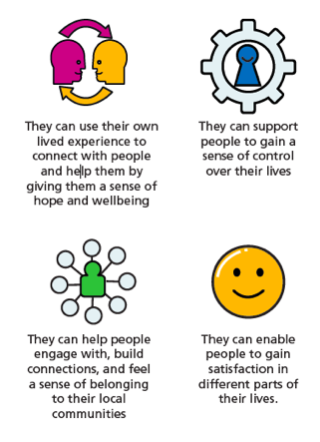 Figure 1: Having a peer support mentor has many advantages
Figure 1: Having a peer support mentor has many advantages
Peer support can enhance personal development and provide relevant information that cannot be obtained in any other way. Peer mentors often provide information about local support systems. Peer support also provides a way to address personal and complex problems. It is effective in reaching, educating and supporting the most vulnerable people.
Peer support can promote pride, satisfaction and continuity in mentoring. Peer-to-peer activities offer vulnerable people the opportunity to give back to their community, develop a sense of purpose and a greater sense of identity.
Finally, peer support activities also benefit organisations and the community. The public can form a more positive image of migrant women living independently and increase their interaction with them.
A range of program types exist, here are some examples:
- Drop-in spaces: A drop-in space is a casual, no-commitment-required way to engage in a variety of experiences that allow you to find connection and support by processing thoughts and feelings, getting advice and feedback from peers.
- Peer support groups: A regular gathering where individuals share with one another their lived experiences, struggles and challenges. The group gathers on a regular basis and usually these interactions are supervised by a trained peer support facilitator.
- Skill-development programs: Skill development programs aim to acknowledge the skills gap of individuals. Providing them with the proper guidance and training of skills (transferable to their day-to-day life and context), individuals are encouraged to better their lives and/or achieve their ambitions.
For this module, we considered online support. This is beneficial because it uses technology to connect participants. It can offer support anonymously and without bias, it can be public (open to all users) or private, and it can be offered through a discussion forum, chat, email or live meetings.
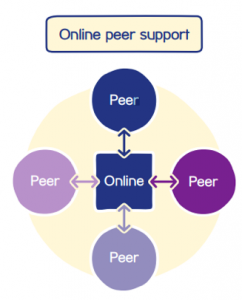
Figure 2: Graphic retrieved from the “Developing peer support in the community” toolkit.
When planning peer-to-peer activities, it is essential to first provide guidance on online support so that users are successful and get what they need from this model. Choose a platform that is easily accessible. Consider having a moderator monitor usage for security reasons. Offer ongoing technical support. Consider using more than one platform for connectivity. Provide guidelines to help online support users. Provide clear training and guidelines for facilitators providing online peer support.
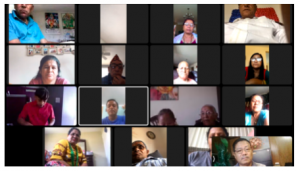
Figure 3: Example of online peer support group
A successful peer support programme is one that evolves over time to meet the social and emotional needs of the users. The best way to find out if your programme is making a difference and meeting the needs of your clients is to evaluate it regularly.
Whether you plan to develop a peer support programme from scratch or adapt an existing programme, an effective and sustainable programme requires careful organizational skills, clearly described protocols, an appropriate process for recruiting and selecting peer supporters, and adequate training before peer supporters are deployed.
Starting a peer support programme
When implementing a peer support programme, you need to think about what kind of support people need and how your programmes can meet those needs. This requires consideration of the needs and strengths of your organisation, the target group you want to address, the peer supporters and their requirements for support, and your ideas about what peer support might look like in your setting.
The implementation or strengthening of peer support activities usually goes through four phases, which include:
- Collaborative and organisational preparation - e.g. assessing needs, obtaining consent from stakeholders and securing resources.
- Activity development - planning peer support activities, developing protocols and recruiting and training peer supporters.
- Activity implementation - reaching and engaging programme participants and supervising and supporting peer supporters.
- Evaluation of the activities - Documenting the process and identifying indicators and tools to assess outcomes and impact.
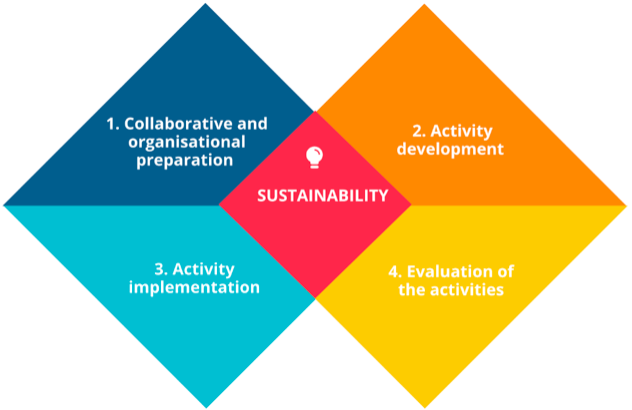
Figure 4. Four phases of program development and management
Once the peer support activity is up and running, it is not uncommon for things not to go as planned. A successful activity requires good management and continuous problem solving. This part focuses on solving problems related to peer supporters and participants. You will be given tips and tools to manage the retention and turnover of peer supporters, adopt a constructive approach to mentoring, and reach out to and engage programme participants.
A carefully designed and implemented evaluation can help strengthen and sustain peer support activities. Depending on your goals, different methods can help you address day-to-day challenges, understand how peer support is delivered, and also know and demonstrate the impact of the programme.

Figure 6: Example of a support group evaluation form
Some centres have volunteer coordinators who have a variety of responsibilities, including working directly with users.
The Peer Mentor Programme Coordinator's responsibilities include recruiting mentors, training mentors and briefing mentors on the philosophy of independent living and the history of the independent living movement. The mentor is responsible for setting up and overseeing matches. Supervises mentors when they work with users and conducts a programme assessment that mentors complete when they work with an individual. Finally, he/she is responsible for supporting and recognising volunteers.
This means that clients who participate in the mentoring programme work with other staff on goal setting and planning. Once a client has had the opportunity to learn about the mentoring programme and has made the decision that they would like to participate, they are referred to the volunteer coordinator to be matched with a mentor.
Adapting a peer support programme
An adapted peer support programme is more likely to succeed if it maintains the established peer support framework while modifying programme components to fit the target population, increase cultural competence and address community needs. In general, the different adaptation guidelines have the following steps in common:
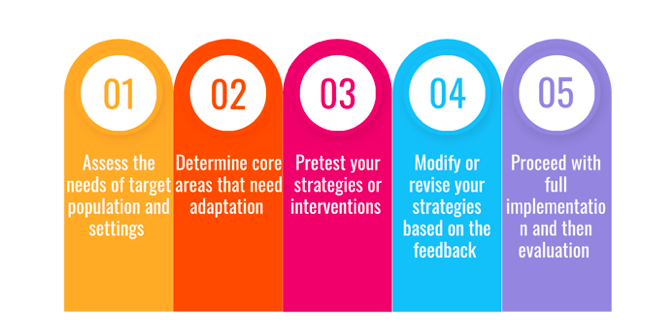
Figure 6. Framework for Adaptation
When adapting an existing program, the key is to continually change or revise your approaches based on the needs and characteristics of your program participants and environments. Continuous Quality Improvement (CQI) applies to all peer support programs, whether they are being built from scratch or adapting an existing model.
There is no single ingredient that is required or guarantees success, but these components often make successful peer support programs.
- Maintain frequent contact (long-term and ongoing support).
- Help develop problem-solving, decision-making, and coping skills.
- Consider the individual, social, and cultural characteristics of the user.
- Consider individual rights, privacy, and the limits of the peer supporter's role.
Summary
In this chapter, we provide some of this historical information and give an overview of the most widespread ideas about the importance of peer support and its implementation. It is about planning peer support activities, their development and subsequent evaluation. We recommend that you consult the information contained in it, as it will be relevant to your training on this topic, or keep this guide as a resource for other activities.
Learning Outcomes
By the end of this module you will be able to:
- Be able to plan a peer-to-peer activity
- Recognise the different parts into which planning is divided.
- interpret the roles of mentors, users and partnerships.
- recognise how e-learning works.
Self-assessment
Suggested resources
- Donna Kruck, A., Whitaker Lee, P., Reed, A., Lynn Jones, D., & Hammond, M. (2011). Building an Effective Peer Support Program. Retrieven from Microsoft Word - Peer Support Course Manual_May 2011 _2_.doc (ilru.org) https://www.ilru.org/sites/default/files/Peer_Support.pdf
- Cowie, H & Wallace, P 2000, ‘Peer Support in Action’, Sage Publications, London, pp.176.
- Burmaster, E 2002, Youth to Youth: A review of peer program theoretical underpinnings, forms, functions, and process- and outcome-related findings 2001-02. A literature review, Wisconsin Department of Public Instruction. https://mypeer.org.au/planning/what-are-peer-based-programs/
- 10 Steps to build your peer support program. https://www.iaff.org/wp-content/uploads/2019/04/41972_How_to_Build_Your_Peer_Support_Program.pdf
- Side by Side Research Consortium (2017) Developing peer support in the community: a toolkit. London: Mind. https://www.mind.org.uk/media-a/4247/peer-support-toolkit-final.pdf
References
- Starting a peer support program. Peers for Progress. (n.d.). Retrieved from http://peersforprogress.org/resource-guide/starting-a-peer-support-program/
- Doull, M, O’Connor, A, Robinson, V, Tugwell, P & Wells, G 2005, ‘Peer support strategies for improving the health and well-being of individuals with chronic diseases’, Cochrane Database of Systematic Reviews, vol. 1.
